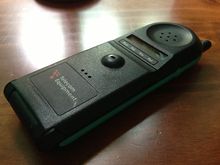Difference between revisions of "CallZone"
Apex-LW'21 (talk | contribs) m |
Apex-LW'21 (talk | contribs) |
||
| Line 11: | Line 11: | ||
===Criticism=== | ===Criticism=== | ||
It is widely reported that areas with CALLZONE base stations also had | It is widely reported that areas with CALLZONE base stations also had payphones located in the vicinity, thus negating the need for one. | ||
In 1993, The Straits Times reported that too many users were making calls on their zonephones at the same time, thus jamming the network.<ref>[http://newspapers.nl.sg/Digitised/Issue/straitstimes19931214-1.aspx The Straits Times 14 December 1993]</ref> | In 1993, The Straits Times reported that too many users were making calls on their zonephones at the same time, thus jamming the network.<ref>[http://newspapers.nl.sg/Digitised/Issue/straitstimes19931214-1.aspx The Straits Times 14 December 1993]</ref> | ||
Revision as of 20:18, 26 November 2013
CallZone was a service offered by PageLink, a subsidiary of SingTel (then known as Telecommunications Equipment) in the 1990s. The service allowed users to make, but not receive, calls using a special handset made by Motorola, in certain designated zones. The technology was similar to the CT2 TelePoint service already established earlier in Britain.
Description
When exactly the CallZone service was introduced is unclear. It is widely stated that the service was introduced sometime in 1990-1992. However, an article from July 1994 states that the service was introduced in May 1994.[1]
Users who subscribed to the service were given a Motorola-made flip-phone to make calls. These calls could only be made in certain areas with a CALLZONE sign; as of May 2009, some of these signs can still be found around the island. It is unknown how many different models were built, but one was notable for having a built-in pager. This same model was a flip-phone in the style of the MicroTAC, and had rubber trimming on the sides that came in multiple colours. The handset retailed for S$350.[2]
The network was shut down in July 1998.[3]In a letter to 3,500 subscribers explaining the shutdown, SingTel said that the service was not financially viable because of the emergence of low-cost cellular handsets. Additionally, Motorola had stopped making the handsets.[4]
A similar service, also utilising the same pager-phone, was also offered by Hutchison Paging in Hong Kong.[5]
Criticism
It is widely reported that areas with CALLZONE base stations also had payphones located in the vicinity, thus negating the need for one.
In 1993, The Straits Times reported that too many users were making calls on their zonephones at the same time, thus jamming the network.[6]
SingTel CallZone
The CallZone name was resurrected for a service, also offered by SingTel. The service allows SingTel subscribers to make free mobile phone calls, using a special device connected to a SingNet Broadband modem.
